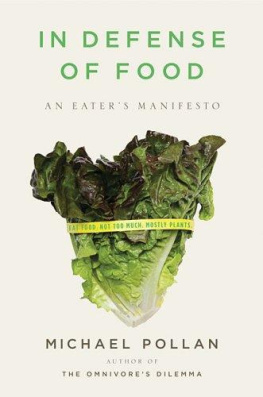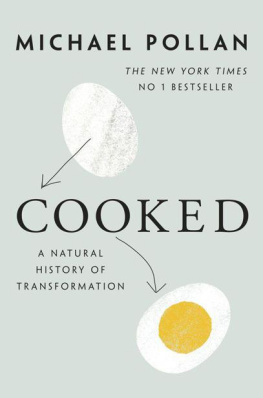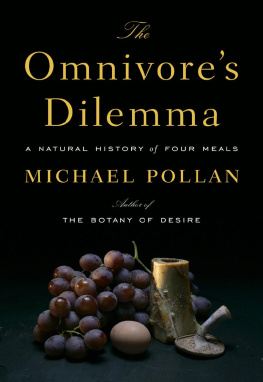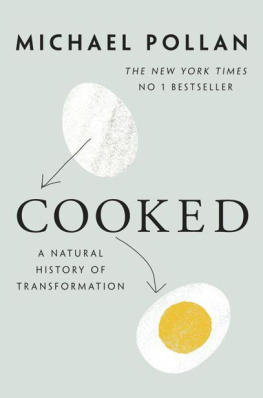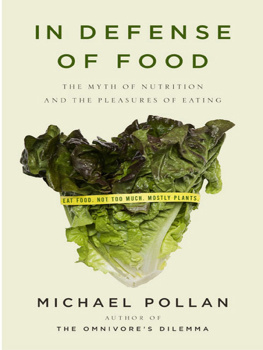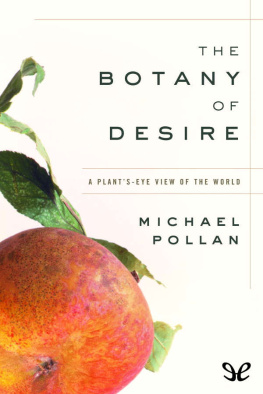Michael Pollan - In defense of food: an eaters manifesto
Here you can read online Michael Pollan - In defense of food: an eaters manifesto full text of the book (entire story) in english for free. Download pdf and epub, get meaning, cover and reviews about this ebook. year: 2009, publisher: Penguin Press, genre: Science. Description of the work, (preface) as well as reviews are available. Best literature library LitArk.com created for fans of good reading and offers a wide selection of genres:
Romance novel
Science fiction
Adventure
Detective
Science
History
Home and family
Prose
Art
Politics
Computer
Non-fiction
Religion
Business
Children
Humor
Choose a favorite category and find really read worthwhile books. Enjoy immersion in the world of imagination, feel the emotions of the characters or learn something new for yourself, make an fascinating discovery.
- Book:In defense of food: an eaters manifesto
- Author:
- Publisher:Penguin Press
- Genre:
- Year:2009
- Rating:3 / 5
- Favourites:Add to favourites
- Your mark:
- 60
- 1
- 2
- 3
- 4
- 5
In defense of food: an eaters manifesto: summary, description and annotation
We offer to read an annotation, description, summary or preface (depends on what the author of the book "In defense of food: an eaters manifesto" wrote himself). If you haven't found the necessary information about the book — write in the comments, we will try to find it.
In defense of food: an eaters manifesto — read online for free the complete book (whole text) full work
Below is the text of the book, divided by pages. System saving the place of the last page read, allows you to conveniently read the book "In defense of food: an eaters manifesto" online for free, without having to search again every time where you left off. Put a bookmark, and you can go to the page where you finished reading at any time.
Font size:
Interval:
Bookmark:
* Orthorexia from the Greek ortho- (right and correct) + exia (appetite) = right appetite. The term was first proposed in 1996 by the American physician Steven Bratman. Though orthorexia is not yet an eating disorder recognized by the Diagnostic and Statistical Manual of Mental Disorders, academic investigation is under way.
*Gary Taubes describes the developing carbohydrate hypothesis at great length in Good Calories, Bad Calories. According to the hypothesis, most of the damage to our health that has been wrongly attributed to fats for the past half centuryheart disease, obesity, cancer, diabetes, and so oncan rightly be blamed on refined carbohydrates. But the healthy skepticism Taubes brought to the lipid hypothesis is nowhere in evidence when he writes about the (also unproven) carbohydrate hypothesis. Even if refined carbohydrates do represent a more serious threat to health than dietary fat, to dwell on any one nutrient to the exclusion of all others is to commit the same reductionist error that the lipophobes did. Indeed, Taubes is so single-minded in his demonization of the carbohydrate that he overlooks several other possible explanations for the deleterious effects of the Western diet, including deficiencies of omega-3s and micronutrients from plants. He also downplays the risks (to health as well as eating pleasure) of the high-protein Atkins diet that the carbohydrate hypothesis implies is a sound way to eat. As its title suggests, Good Calories, Bad Calories, valuable as it is, does not escape the confines of nutritionism.
*In fact, the magnitude of the error could be much greater, judging by the huge disparity between the total number of food calories produced every day for each American (3,900) and the average number of those calories Americans own up to chomping each day: 2,000. Waste can account for some of this disparity, but not nearly all of it.
*According to Walter C. Willett, only 3.1 percent of the Nurses Health Study population could be described as following a low risk diet and lifestyle, which he defines as follows: nonsmoker, body-mass index (BMI) below 25 (the threshold for overweight), thirty minutes of exercise a day, and a diet characterized by low intake of trans fat; high ratio of polyunsaturated to saturated fats; high whole-grain intake; two servings of fish a week; recommended daily allowance of folic acid and at least five grams of alcohol a day. Based on fourteen years of follow-up, Willett and his colleagues calculated that, had the entire cohort adopted these behaviors, 80 percent of coronary heart disease; 90 percent of type 2 diabetes, and more than 70 percent of colon cancer cases could have been avoided. This analysis suggests that the worst effects of the Western diet can be avoided or reversed without leaving civilization. Or, as Willett writes, the potential for disease prevention by modest dietary and lifestyle changes that are readily compatible with life in the 21st century is enormous. From Walter C. Willet, The Pursuit of Optimal Diets: A Progress Report in Jim Kaput, and Raymond L. Rodriguez, Nutritional Genomics: Discovering the Path to Personalized Nutrition (New York: John Wiley & Sons, 2006).
*It may be that the explosion of chronic diseases during the twentieth century is now taking a toll on American life expectancy. In 2007, the CIA World Factbook ranked the United States forty-fifth for life expectancy at birth, below countries like Israel, Jordan, Bosnia, and Bermuda. Future gains in life expectancy depend largely on how much we can extend life among the elderlyexceedingly difficult, when you consider that the incidence of diabetes in people over seventy-five is projected to increase 336 percent during the first half of this century.
*Modern Civilization, Nutritional Dark Age: Weston A. Prices Ecological Critique of the Industrial Food System, 2005.
*Glucose is a sugar molecule that is the bodys main source of energy; most carbohydrates are broken down to glucose during digestion. Fructose is a different form of sugar, commonly found in fruit. Sucrose, or table sugar, is a disaccharide consisting of a molecule of glucose joined to a molecule of fructose.
*David R. Jacobs and Lyn M. Steffen, Nutrients, Foods, and Dietary Patterns as Exposures in Research: A Framework for Food Synergy, American Journal of Clinical Nutrition, 2003; 78 (suppl): 508S13S.
*Fructose is metabolized differently from glucose; the body doesnt respond to it by producing insulin to convey it into cells to be used as energy. Rather, it is metabolized in the liver, which turns it first into glucose and then, if there is no call for glucose, into triglyceridesfat.
*In the past, changes in the food environment have led to measurable changes in human biology over time. A recent study found that populations eating a high-starch diet have more copies of a gene coding for amylase, the enzyme needed to break down starch. The authors of the study suggest that natural selection has favored the gene in those populations that began eating cereal grains after the birth of agriculture. George H. Perry, et al., Diet and the Evolution of Human Amylase Gene Copy Number Variation, Nature Genetics published online September 9, 2007; doi:10.1038/ng2123.
*The news of declining nutrient levels in American produce prompted The Packer, a trade publication for the produce industry, to suggest that this might actually be good for business, because people would now need to eat more produce to get the same nutritional benefit.
*Sucrose is the exception that proves the rule. Only the power of the sugar lobby in Washington can explain the fact that the official U.S. recommendation for the maximum permissible level of free sugars in the diet is an eye-popping 25 percent of daily calories. To give you some idea just how permissive that is, the World Health Organization recommends that no more than 10 percent of daily calories come from added sugars, a benchmark that the U.S. sugar lobby has worked furiously to dismantle. In 2004 it enlisted the Bush State Department in a campaign to get the recommendation changed and has threatened to lobby Congress to cut WHO funding unless the organization recants. Perhaps we should be grateful that the saturated fat interests have as yet organized no such lobby.
*These are USDA statistics from FoodReview, Vol. 25, Issue 3, a publication of the Economic Research Service at the USDA.
*Alpha-linolenic acid is the omega-3 fatty acid found in all green plants; it is the most common fat in nature. Fish contain even more valuable long-chain forms of omega-3, like EPA and DHA, which they get from the algae at the base of their food chain.
The Queen of Fats: Why Omega-3s Were Removed from the Western Diet and What We Can Do to Replace Them (Berkeley: University of California Press, 2006).
*Joseph Hibbeln, et al., Healthy Intakes of n-3 and n-6 Fatty Acids: Estimations Considering Worldwide Diversity, American Journal of Clinical Nutrition, 2006; 83 (suppl): 1483S93S.
M. L. Daviglus, Fish Consumption and the 30-Year Risk of Myocardial Infarction, New England Journal of Medicine, 1997; 336: 104653. K. W. Lee and G. Y. Lip, The Role of Omega-3 Fatty Acids in the Secondary Prevention of Cardiovascular Disease, QJM: An International Journal of Medicine, 2003 July; 96(7):46580.
*Joseph Hibbeln, et al., Healthy Intakes of n-3 and n-6 Fatty Acids: Estimations Considering Worldwide Diversity, American Journal of Clinical Nutrition, 2006; 83 (suppl): 1483S93S.
*Several studies have found that when industry funds nutrition research, the conclusions are more likely to produce findings favorable to that industrys products. One such previously cited study, published by the Public Library of Science, is Relationships Between Funding Source and Conclusion Among Nutrition-Related Scientific Articles, by David S. Ludwig, et al. See also Marion Nestles Food Politics: How the Food Industry Influences Nutrition and Health. Revised edition. (Berkeley: University of California Press, 2007).
Next pageFont size:
Interval:
Bookmark:
Similar books «In defense of food: an eaters manifesto»
Look at similar books to In defense of food: an eaters manifesto. We have selected literature similar in name and meaning in the hope of providing readers with more options to find new, interesting, not yet read works.
Discussion, reviews of the book In defense of food: an eaters manifesto and just readers' own opinions. Leave your comments, write what you think about the work, its meaning or the main characters. Specify what exactly you liked and what you didn't like, and why you think so.

